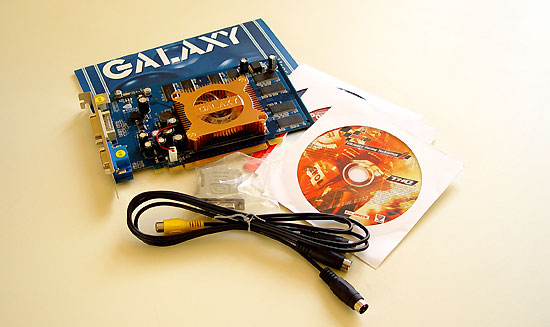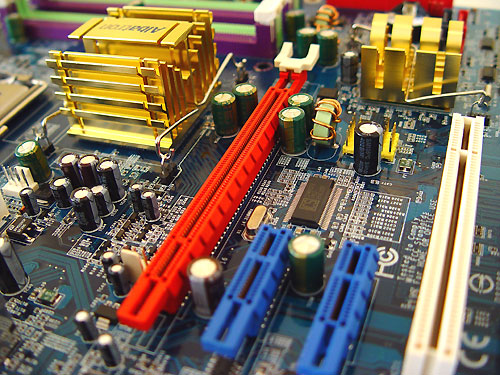Page 2
As you have noticed, the GeForce 6600 GT cards come with a 500 MHz clock and memory rate, 128-bit (GDDR3, 128 MB) with a suggested pricetag of $/EUR229. The standard GeForce 6600 will also come with the 128-bit bus (GDDR, 128/256 MB), will cost about $150 and has a way lower 300 MHz core clock. The memory clock is something that can be decided by the manufacturer, however. You'll notice that this particular Galaxy model has a 325 MHz core, at default they'll deliver this product with a slightly faster core.
It doesn't end there though... how does 550 MHz on the core sound? It's no joke, you'll read all about it in the overclocking part.
The product
has 8 Pixel pipelines and 3 Vertex processors that are confirmed to be working 100% with Rivatuner. The 6600 series can write only four color pixels per clock and has a fragment crossbar. The NV43 does appear to have eight pixel shader/texture units, so its not an "8 x 1" design or a "4 x 1" design. It's more of a hybrid and works quite well.

The card itself is reference based, except for the nice blue colored PCB that is. What I really like is that even for this somewhat cheaper product a better cooling solution, as opposed to the reference cooling, was used. A nice and shiny copper heatsink with an active fan, which is not at all noisy yet seems to be very effective.
The card follows reference specifications except for the slightly increased core frequency:

We're using ForceWare 66.81 for todays review.
$ffffffffff Display adapter information
$ffffffffff ---------------------------------------------------
$0000000000 Description : NVIDIA GeForce 6600
$0000000001 Vendor ID : 10de (NVIDIA)
$0000000002 Device ID : 0141
$0000000003 Location : bus 1, device 0, function 0
$0000000004 Bus type : PCI
$0000000009 Base address 0 : c0000000 (memory range)
$000000000a Base address 1 : b0000000 (memory range)
$000000000b Base address 2 : none
$000000000c Base address 3 : c4000000 (memory range)
$000000000d Base address 4 : none
$000000000e Base address 5 : none
$ffffffffff ---------------------------------------------------
$ffffffffff NVIDIA specific display adapter information
$ffffffffff ---------------------------------------------------
$0100000000 Graphics core : NV43 revision A2 (8x1,3vp)
$0100000001 Hardwired ID : 0141 (ROM strapped to 0141)
$0100000002 Memory bus : 128-bit
$0100000003 Memory type : DDR (RAM configuration 01)
$0100000004 Memory amount : 262144KB
$0100000005 Core clock : 324.000MHz
$0100000006 Memory clock : 275.400MHz (550.800MHz effective)
$0100000007 Reference clock : 27.000MHz
$ffffffffff ---------------------------------------------------
$ffffffffff NVIDIA VGA BIOS information
$ffffffffff ---------------------------------------------------
$1100000000 Title : GeForce 6600 BIOS
$1100000002 Version : 5.43.02.16
$1100000100 BIT version : 1.00
$1100000003 SW masked units : none
The Installation
It's really not hard to install a graphics card yourself nowadays. Especially with brands like ATI and NVIDIA, who use unified driver sets. If you have a really new product then make sure you have the latest drivers on your HD. First uninstall your current graphics card's drivers carefully, this is very important especially if the older graphics card was from a different chipset manufacturer. Now power down the PC and pull out the power cable. Insert the graphics card in the slot, secure it with a screw, connect the monitor and boot up windows, run the driver installation, then restart and you are set to go. That's all. Also important, make sure you have the latest version of DirectX (9.0c) installed. If you experience compatibility issues, please make sure you installed the latest version of your mainboard drivers, have a look in our download section I'd say.
Latest software Downloads
- For NVIDIA Cards - ForceWare drivers
- For ATI cards - Catalyst drivers
- Microsoft DirectX 9.0c
PCI-Express
PCI Express is a new development in I/O interconnect standards that companies like NVIDIA, ATI and many others will deploy in future graphics solutions. With up to 4GB/s of one-directional and 8GB/s of concurrent bandwidth you can be sure to have high-speed graphics output. PCI Express significantly increases bandwidth between the central processing unit (CPU) and graphics processing unit (GPU). We are not yet 100% sure if Series 6600 uses HSI or is a native solution, the AGP version though will be bridged.

1 x16 PCI express (red) slot and next to it are the two (blue) x1 PCI Express slots.
